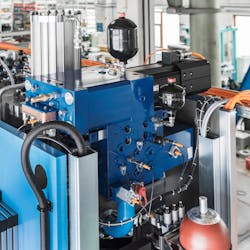Hydraulics in the Internet of Things Era
When hearing the terms Industrial Internet of Things or Industry 4.0, the most common technologies that come to mind are things like advanced Ethernet networks, Big Data, and cloud computing. Hydraulic technologies, on the other hand, do not typically come to rushing to mind.
During my visit last spring to Hannover Fair 2015, I was struck by the focus of Bosch Rexroth’s exhibit on the incorporation of hydraulics into Industry 4.0. A video of what I saw at the Bosch Rexroth exhibit can be seen in this short review of my Hannover Fair 2015 Day One highlights. To learn a bit more about why Bosch Rexroth is highlighting the role of hydraulics in Industry 4.0, I spoke with Dr. Steffen Haack, a member of Bosch Rexoth’s executive board.
The first point Dr. Haack made about hydraulics’ applicability in Industry 4.0 applications is the technology’s capability for “micrometer precision.” He explained that “electrohydraulic axis controllers close the control loop decentrally, similar to electrical servo drives, and harmonize the target or actual position in real time within milliseconds.”
Operating “decentrally” means that the decentralized intelligence in the electronic control device adjusts the rotational speed of the pump drive on demand. “In comparison to common constant drives, this reduces the energy consumption of hydraulic power units by up to 80 percent,” Dr. Haack said. He added that the decentralized nature of electrohydraulics technologies means that even older facilities and machines can be retrofitted “without major efforts” to significantly reduce the energy consumption in production.
While speaking about the retrofitting capabilities of electrohydraulic devices, Dr. Haack noted that Bosch Rexroth’s ready-to-install servo-hydraulic axes have an “integrated fluid loop and are driven by the same servo drives as the electromechanical versions. Since the axes are encapsulated systems, engineers must only connect power and communication cables for assembly and start-up. Everything else, for example the parameterization values determined from simulations, are already stored in the drive software.”
More directly to the point of Industry 4.0 and the Industrial Internet of Things requirement for online communications, Dr. Haack said that “modern motion controls for hydraulic drives support all common protocols, such as Sercos, EtherCAT, EtherNet/IP, Profinet RT, Powerlink and Varan. The software is also based on open standards like IEC 61131-3 and PLCopen. With these capabilities they (hydraulic drives) are an ideal match for the increasingly integrated and technology-overlapping infrastructure of modern production environments —all the way up to Industry 4.0.”
About the Author
David Greenfield, editor in chief
Editor in Chief

Leaders relevant to this article:
